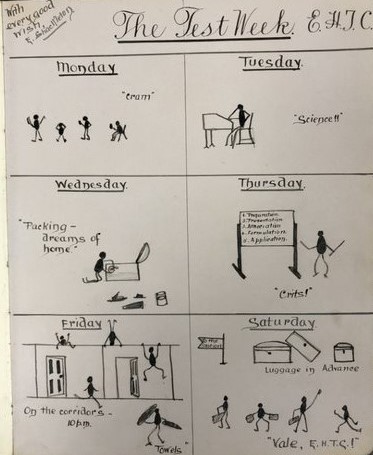I’m sure it’s not just me whose main experience of seeing friends over the past year has been squinting at screens, hoping the broadband holds and occasionally having to shout, “you’re on mute!” Things that were once regular occurrences – meeting up with friends for a drink or popping over to their house for a takeaway – now seem both distant, barely tangible memories and faraway, exciting hopes. And yet, imagine we had not been able to see friends on video calls, to text and email them over the past year. There seems little doubt that technology has, for many of us, eased some of the feelings of isolation the pandemic is causing. Even just a decade or two ago, the experience of living through a global pandemic would have been very different.
Throughout much of Edge Hill’s history, letter-writing was the principal way for students and staff to keep in touch with each other when term ended or graduation created a new wave of long-distance friendships. While private telephones would become increasingly common, they were often shared with housemates or family members, so could lack the sense of privacy and intimacy that letters provided. It comes as no surprise, then, that exchanging home addresses with friends as they left for home was a priority for many students. Nestled within our archive collections are some beautiful examples of the autograph albums that were passed around the halls of residence for students (and possibly staff from time to time) to leave their details in. More often than not, however, these were far more than just autograph albums – most of the signatories would choose to leave a message in the form of a poem, a favourite saying or an artwork – they might more accurately be described as friendship books. The level of thought and effort that was dedicated to each entry is astounding and sometimes, in an age of fast scrolling social media and quickly found gifs expressing our emotions, extremely moving. Some of them even include hand-decorated covers [EHU/GUAL/3/14/1]. All of the friendship books we have date from the earliest days of Edge Hill in the late 19th century to the 1920s; whether this is because such albums dropped out of fashion in this period or simply that we haven’t yet received donations of later examples is hard to say.

As the images show, the artworks represent a variety of styles and reflect some contemporary trends and fashions. Images of children, often saying or doing things expressly designed to elicit coos from the viewer and illustrated in a cartoon-like style were common subjects of mass-produced artworks, postcards and prints. Likewise, single illustrations with a humorous caption were common and it is probable that most of the examples in the albums were copied from other sources. Of course, this kind of illustration remains popular today – just think of the many greetings card designs that still rely on this format.

Some of the artworks, poems and messages are wonderful time capsules of life at Edge Hill in a different era. For example, “The Test Week” is a comic book style artwork by F. Shackleton from the 1890s that describes the students’ lives during the week of a test [EHU/GUAL/3/12/1]. The neatly drawn images, populated by stick figures, may be simple, but they are surprisingly expressive and still ring true today: the last minute cramming, the home sickness and the excitement when the test is over (although if someone can explain to me what towels have to do with this, I’d be grateful!)
By far the most common type of entry are quotes. Usually, these are from literature and occasionally popular sayings and phrases are included; playing a similar role, perhaps, to the kinds of “inspirational” memes and phrases that are regularly shared on social media today. The quotes are usually very short and were presumably from memory, from books the student owned or maybe from the Edge Hill library. Sometimes, the friendship books contain very creative approaches to including quotes – see, for example, Alice Gardner’s lovely “Patchwork Page” from 1912 [EHU/GUAL/3/15/1]– and were clearly laid out with considerable care.

There is a wonderful charm to these autograph albums. They are a fascinating glimpse into a more personal history of Edge Hill and the lives of some of our earliest students. At a time when the bonds with our friends are most keenly felt and we long for a time when we can once again see them in the flesh, these albums remind us of the importance that friendship has always played in people’s lives.
by Dan Copley – Archivist

One response to “Friendship Books”
I remember some of these arriving via the alumni office and thought they were fascinating. I’m glad thay are getting attention.